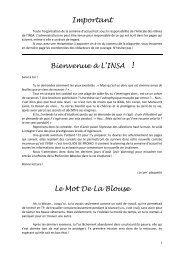Faery's Tale Deluxe - Etud
Faery's Tale Deluxe - Etud
Faery's Tale Deluxe - Etud
You also want an ePaper? Increase the reach of your titles
YUMPU automatically turns print PDFs into web optimized ePapers that Google loves.
<strong>Tale</strong>s of the Fey<br />
Creating Adventures<br />
As the Narrator, it’s your job to come up with<br />
the adventures on which the heroic faeries<br />
of the players will embark. Fortunately, you<br />
don’t have to map out every twist and turn in<br />
advance. In fact, it’s better if you don’t, since<br />
the players will inevitably do things you never<br />
expected that take the story in whole new<br />
directions. Focus on the<br />
broad outline of the plot,<br />
particularly the starting<br />
point, and on what the<br />
antagonists are going to<br />
be doing. Don’t spend<br />
too much time trying<br />
to anticipate the actions<br />
of the players, and never<br />
devise a plot that hinges<br />
on a single action or a particular clue.<br />
If you’re uncertain about your storytelling<br />
abilities, start off by adapting favorite faery<br />
tales, such as the Jack and the Beanstalk<br />
Come play with me,<br />
I’ll tell you of the moon,<br />
And of the stars that shine and glitter.<br />
I’ll speak to you of fairy worlds,<br />
Of happiness and splendor.<br />
For Kids<br />
— 64 —<br />
adventure in this chapter. Change the original<br />
story just enough to make the faeries controlled<br />
by the players the center of attention. Often,<br />
this will involve having them rescue or help<br />
the original protagonist of the faery tale, such<br />
as saving Jack from the giant or Hansel and<br />
Gretel from the hag.<br />
But coming up with<br />
your own ideas for<br />
stories can be even more<br />
rewarding, especially<br />
—Sir J.M. Barrie<br />
since you can tailor<br />
them to the talents,<br />
interests, and desires of<br />
the players. Just think<br />
of the faeries as comicbook<br />
superheroes—<br />
unbeknownst to most people, they have<br />
amazing powers which they use to right<br />
wrongs, rescue others from danger, and, once<br />
in a while, save the world.<br />
Children at various ages have specific developmental issues that it’s useful for<br />
Narrators to keep in mind. Individual children go through these stages at different<br />
ages (and some stages are skipped entirely), so these are only rough guidelines of things<br />
Narrators should look out for.<br />
Children younger than 6 years old often have trouble remembering and following<br />
rules consistently.<br />
Moral issues are likely to confuse or bore children younger than 8.<br />
By age 9, kids can handle looser enforcement of the rules of a game without running<br />
rampant. They also are strong at conceptualization with language, making this a good<br />
starting age for interactive storytelling games featuring simple concepts like, “Defeat an<br />
evil dragon, then go look for another to defeat.”<br />
From ages 10 to 12, social skills become important, and literary influences begin to<br />
really ramp up. The children become more interested in their roles within a group, as<br />
opposed to just what the group does and the story of the game.<br />
The concept of “personal epic,” where actual success or failure is less important than<br />
how the faeries deal with the situation, kicks in around age 11.<br />
Children of different ages (or adults of different tastes) will often have desires for<br />
gameplay that differ, and a Narrator should take care to emphasize the aspects that are<br />
appropriate and that appeal to each player.







